
FREE Short Story: The Seamstress
For your FREE short story, type your email address below.
You'll get the short story, plus fun facts about the Wild West, and news about upcoming stories.

For your FREE short story, type your email address below.
You'll get the short story, plus fun facts about the Wild West, and news about upcoming stories.
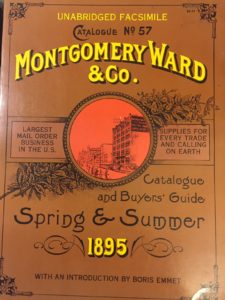 In 1872, a revolution took place, which dramatically changed the lifestyles of Americans, and has influenced how we shop ever since. Aaron Montgomery Ward, a traveling dry goods salesman, published a single sheet of paper, listing an assortment of goods that he could supply from his small warehouse in Chicago. He purchased his goods – hose, gloves, hat trimmings, cutlery, watches, fans, stereoscopes, trunks, handbags, harnesses and simple medicines – directly from the manufacturer, and shipped across the United States, enabling consumers in far-flung rural communities to access items they’d not been able to afford, or even known about, before.
In 1872, a revolution took place, which dramatically changed the lifestyles of Americans, and has influenced how we shop ever since. Aaron Montgomery Ward, a traveling dry goods salesman, published a single sheet of paper, listing an assortment of goods that he could supply from his small warehouse in Chicago. He purchased his goods – hose, gloves, hat trimmings, cutlery, watches, fans, stereoscopes, trunks, handbags, harnesses and simple medicines – directly from the manufacturer, and shipped across the United States, enabling consumers in far-flung rural communities to access items they’d not been able to afford, or even known about, before.
By 1884, his catalogue included 10,000 household and farming goods on 240 pages, and illustrated each item with the traditional woodcut we associate with that era.
The terrific vo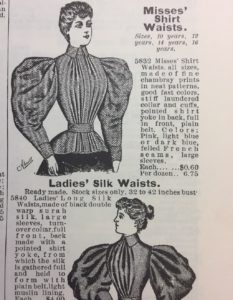 lume of Montgomery Ward’s business, made possible by the continent’s railroads, enabled the company to offer goods at very reasonable prices, and so, for the first time in history, ordinary farmers and factory workers could purchase more than just the basic clothes needed for their daily lives; they could access fashion!
lume of Montgomery Ward’s business, made possible by the continent’s railroads, enabled the company to offer goods at very reasonable prices, and so, for the first time in history, ordinary farmers and factory workers could purchase more than just the basic clothes needed for their daily lives; they could access fashion!
My 1895 reprint of the catalogue gives a wonderful insight into the liv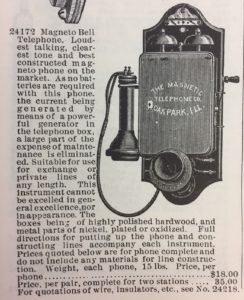 es of people in that time: what they wore, how they cooked, what animals they kept, what level of technology was commonplace. For example, although the telephone had been patented in 1876, the catalogue of 1895 only lists one such device for purchase, stating ‘the phone will work on a line half a mile long’ and ‘Prices quoted below are for phone complete and do not include any materials for line construction.’ So telephone exchanges were still not accessible for most people.
es of people in that time: what they wore, how they cooked, what animals they kept, what level of technology was commonplace. For example, although the telephone had been patented in 1876, the catalogue of 1895 only lists one such device for purchase, stating ‘the phone will work on a line half a mile long’ and ‘Prices quoted below are for phone complete and do not include any materials for line construction.’ So telephone exchanges were still not accessible for most people.
Another exa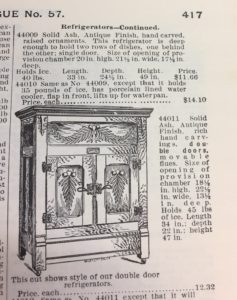 mple is of the refrigerator. There were electricity power stations in the 1890s, but the catalogue lists no electric refrigerators, only boxes cooled by means of ice blocks.
mple is of the refrigerator. There were electricity power stations in the 1890s, but the catalogue lists no electric refrigerators, only boxes cooled by means of ice blocks.
An interesting contraption available to consumers in those days is a dog-powered butter churn. What every household needs!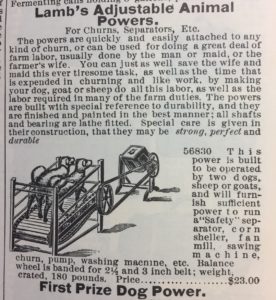
It’s very straightforward to find out any matter on web as
compared to books, as I found this post at this website.
Thanks for your comment. Yes, I’ve done most of my research on the web, and it’s amazing what resources are available! However, I do love paging through the Catalogue, and there are some primary sources that haven’t been scanned onto the internet yet, like the ‘Chronicles of Oklahoma’, a periodical with lots of useful articles for my topic. Their older editions aren’t on the web, and I absolutely had to have an article about a few Cherokee homesteaders during the Great Land Rush of 1893. Fascinating stuff. My next Scribbling will give more detail.
Great content! Super high-quality! Keep it up! 🙂
Thanks! I’ll have another post soon.
Guess what? My family had an icebox refrigerator until about 1951. Ice blocks were still delivered every week.
Wow! Thanks, Patricia. I love it when ‘history’ is something we can connect with directly.
Wonderful! FYI – my dogs are definitely not pulling their weight! I need that butter churn!?
That’s for sure! Or what about hooking up a hamster wheel to our smoothie maker…